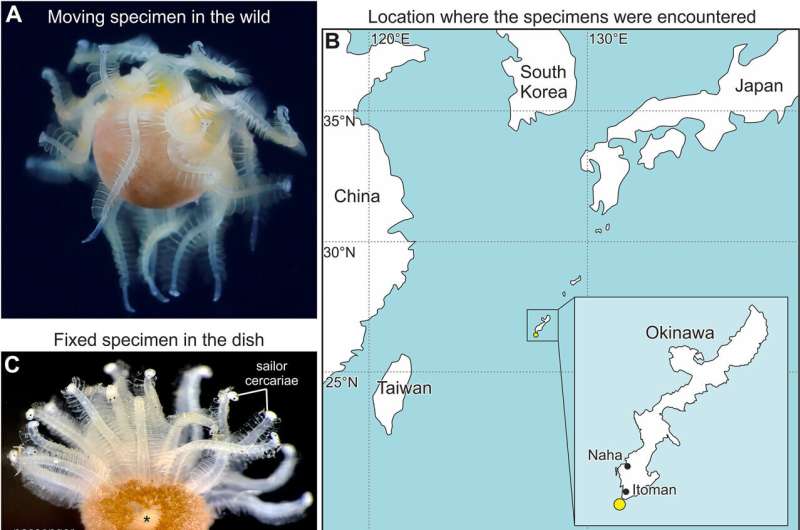Researchers identify tiny, unique sea creature photographed in 2018

An international team of zoologists and parasitic worm specialists has identified an odd sea creature captured by an underwater photographer in 2018 off the coast of Okinawa. In their project, reported in the open-access journal Current Biology, the group obtained and studied a sample of the sea creature.
Shortly after he captured images of the creature, photographer Ryo Minemizu posted them online, asking if anyone knew what it was. None of his followers had seen anything like it before. Intrigued, Minemizu went back to where he had seen the creature and found it, or another one like it. He captured the ladybug-sized creature and stored it until it caught the attention of the research team. Minemizu sent them the sample and then awaited the results of their investigation.
The research team found that it was actually two creatures holding tightly to one another. Both were types of cercariae—parasitic larvae worms. The researchers dubbed one type "sailors" and the other "passengers," because of the roles they played when bonded together.
The passengers were much smaller than the sailors, and the two held tightly to one another, forming a flat-topped hemisphere. They squeezed themselves together with their heads pointed toward the inside of the sphere, leaving their tails exposed and forming the exterior of the hemisphere. The sailors latched onto the passenger tails with their own tails and stretched out their bodies into the water, resembling appendages of the sphere.
Further study of the two-creature grouping showed that the sailors used their bodies like appendages, swinging them like cilia on paramecia. And like the cilia, the sailors moved their bodies in unison as a means of moving the combined mass around in the water.
The researchers found that such swimming was typically initiated by just one member of the group—its actions were mimicked by those nearby until all were waving, pushing the aggregate through the water. By doing so, the collectivized group could make sudden movements, jumping from point to point, or it could move steadily. The researchers suggest the two creatures have formed a colonial organism that suits the needs of both groups.
More information: Darya Krupenko et al, Polymorphic parasitic larvae cooperate to build swimming colonies luring hosts, Current Biology (2023). DOI: 10.1016/j.cub.2023.08.090
Journal information: Current Biology
© 2023 Science X Network
No comments:
Post a Comment